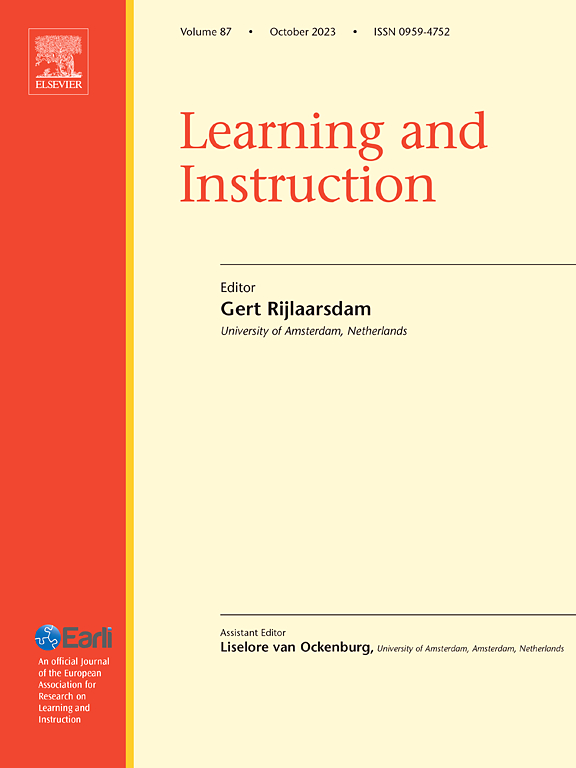对运算顺序和结合律使用的误解
IF 4.7
1区 教育学
Q1 EDUCATION & EDUCATIONAL RESEARCH
引用次数: 0
摘要
数学的概念知识对数学的进步是必不可少的。联想性是一个概念,它允许用不同的方法解决一些问题;例如,用“b - c”解“a + b - c”,再用“+a”解“a + b - c”,这是一种源于结合律的“捷径”策略。然而,个人难以运用联想性和对操作顺序的误解可能是一个负责任的因素。目的探讨对运算顺序的误解是否会阻碍联想捷径的使用。样本76人(研究1)和130人(研究2)年龄在18-60岁之间。方法在研究1中,我们开发了一种新的工具,可以定量测量人们如何解释操作顺序。在研究2中,我们进行了一个强有力的、预先注册的实验,以调查提醒个体正确的操作顺序是否提高了a)对操作顺序的认识和b)联想捷径的使用。结果我们发现,只有16%的成年人完全理解操作顺序,近50%的人在教授时对缩略语有特定的“字面”和“从左到右”的误解。有误解的人较少使用联想捷径。提醒个体操作顺序减少了对操作顺序的误解,但并没有提高联想快捷方式的使用。结论对运算顺序的误解阻碍了联想捷径策略的应用。我们的研究结果对算术的程序性知识和概念性知识之间的关系具有理论影响,并对使用我们的工具识别错误观念的教师有实际好处。本文章由计算机程序翻译,如有差异,请以英文原文为准。
Misconceptions of the order of operations and associativity use
Background
Conceptual knowledge of arithmetic is essential for progressing in mathematics. Associativity is one concept, which permits some problems to be solved in different ways; for example, solving ‘a + b – c’ by ‘b – c’ then ‘+a’ is a ‘shortcut’ strategy derived from associativity. However, individuals struggle to apply associativity and misconceptions of the order of operations may be one factor that is responsible.
Aims
To investigate whether misconceptions of the order of operations hinder associativity shortcut use.
Samples
76 (Study 1) and 130 (Study 2) adults aged 18–60 years participated.
Method
In Study 1, we developed a novel instrument that quantitatively measures how people interpret the order of operations. In Study 2, we conducted a well-powered, pre-registered experiment to investigate whether reminding individuals of the correct order of operations improved a) knowledge of the order of operations and b) associativity shortcut use.
Results
We found that only 16% of adults fully understood the order of operations and almost 50% had specific ‘literal’ and ‘left-to-right’ misconceptions of acronyms used to teach it. Those with misconceptions were less likely to use associativity shortcut. Reminding individuals of the order of operations reduced misconceptions of the order of operations but did not improve associativity shortcut use.
Conclusions
Misconceptions of the order of operations hinder the application of associativity shortcut strategies. Our findings have theoretical impact on the relationship between procedural and conceptual knowledge of arithmetic and have practical benefits for teachers who could use our instrument to identify misconceptions.
求助全文
通过发布文献求助,成功后即可免费获取论文全文。
去求助
来源期刊

Learning and Instruction
Multiple-
CiteScore
11.30
自引率
4.80%
发文量
109
期刊介绍:
As an international, multi-disciplinary, peer-refereed journal, Learning and Instruction provides a platform for the publication of the most advanced scientific research in the areas of learning, development, instruction and teaching. The journal welcomes original empirical investigations. The papers may represent a variety of theoretical perspectives and different methodological approaches. They may refer to any age level, from infants to adults and to a diversity of learning and instructional settings, from laboratory experiments to field studies. The major criteria in the review and the selection process concern the significance of the contribution to the area of learning and instruction, and the rigor of the study.
 求助内容:
求助内容: 应助结果提醒方式:
应助结果提醒方式:


